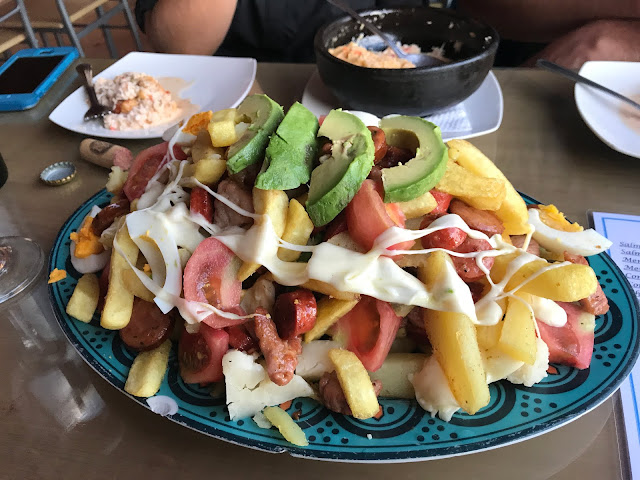 |
| Along the mostly gravel road between Valle Cochamo' and Hornopiren, we had to stop often to drink in the scenery, or on the other end, relieve ourselves. Rest areas? Nada. |
After futile attempts to book an Airbnb, or any other lodging in Hornopiren, we resorted to the old-fashioned method: drive around and hope.
Remember the days before cell phones and GPS when you schlepped from hotel to hotel trying to find an affordable vacancy? I think I still have marks in my palms from clenched fists.
It didn't take long, however, for Chris to notice a big old house with a spiffy paint job and a "rooms for rent" sign out front. A couple cottages were behind the house, and a two-bedroom unit with a tiny kitchen suited us. It cost about $50 a night.
A bonus was the stray German Shepard who hung out on the concrete step and guarded the place.
Unfortunately, not for us, but from us.
Lodging secured, by the dog and our payment, we headed for nearby Hornopiren National Park. It isn't like the national parks we know and love in the USA. In some respects, it's better: wild, untamed, undeveloped, pure wilderness.
 |
The visitors' center was closed and didn't look like it had been open for ages. The park apparently has two trails, and the one we were about to begin led to a mountaintop seven miles distant.
|
On the other hand, the park's trails are not maintained and are inaccessible. We bumped along a few miles of gravel road through private property to reach a trail head, one of only two in the park of 186 square miles of rugged mountains and unspoiled rain forests.
The park includes two volcanoes, 12 square miles of glaciers, and huge stands of Alerce trees, somewhat comparable, in the Chilean world, to the redwood forests of Northern California.
 |
| Alerce trees and us. They will last longer. |
 |
| Really? It gets worse. |
 |
| Let's go for a swim? |
 |
| Loveliness distracted along the way. Although we saw few flowers. |
 |
| We made it intact and still speaking. Still hugging, even. Hanging on for dear life? |
 |
| Back at our modest accommodation, Chris and Chelsea improvise dinner with plenty of wine on the side. Life is good! |
 |
| On the almost six-hour ferry ride the next day. OMG so beautiful! And more fun and challenge are coming. Some things it's better not to know in advance. |
Earlier posts about our South American travels
- Around Cape Horn - Happy 2018!
- Ushuaia, Patagonian peat moss, and a polar plunge
- Patagonian Paradox - the more you see, the more you want
- Penguin drama - #1 attraction near Punta Arenas, Chile
- Magellan was a mean SOB
- Millennials take the lead. Boomers traipse behind.
- Valle Cochamo' and a cool eco lodge






























